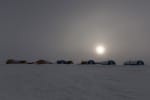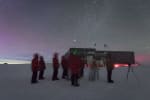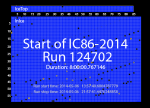A bright moon hovers above a row of summer camp buildings at the South Pole. It’s not summer there now, of course, but with such a brightly lit sky, the winterovers may be having flashbacks to a time not so long ago when the sun shone down on this camp. They still have a way to go before the sun rises here again, with lots of photos to take in the meantime. […]
News
Week 18 at the Pole
What better time and place for an outdoor astronomy class than midwinter at the South Pole? Clear skies present a group of expectant gazers with a multitude of stars for their viewing pleasure. […]
A growing astrophysical neutrino signal in IceCube now features a 2-PeV neutrino
Strong evidence for a very high energy neutrino flux of extraterrestrial origin was found in November 2013, and new data from IceCube now confirms the discovery. Once more, the Antarctic detector brings us still the highest energy neutrino ever observed. […]
The IceCube Masterclass welcomes a hundred students and teachers in Europe and US
The IceCube collaboration is launching a new activity for high school students, the IceCube Masterclass. Students will learn about neutrinos and what they tell us about the universe while also learning about a unique experiment: IceCube, a cubic-kilometer neutrino detector buried in Antarctica’s ice […]
Week 17 at the Pole
It helps for IceCube winterovers to be handy and versatile. With no incoming supplies during the winter months, they have to make do with what they have on hand—if they need a new tool, they craft it, or if something breaks (or rips), they fix it. […]
The start of the IC86-2014 physics run
Around mid-May each year, new detector configurations are applied to IceCube to keep up its performance and to improve scientific results. Last week, on May 6, the IC86-2014 physics run was launched. […]
Week 16 at the Pole
Now there’s a flashy aurora! You know (and it’s not hard to imagine), they say a photo really can’t do justice to these aurora australis—to how impressive they really are when viewed in person. […]
Week 15 at the Pole
This is what the ICL porch looks like as it gets darker outside, bathed in red light (just two short weeks ago things looked a bit different). For the benefit of research projects that monitor the sky during winter darkness, outdoor lighting at the South Pole is minimized and kept to a red spectrum, which reduces interference. […]
Week 14 at the Pole
See anything? Well, there is something there, in this season’s first photo of an aurora from the IceCube winterovers. Many more aurora shots to come, guaranteed. […]
Neutrinos Beyond IceCube
The one-day workshop “Neutrinos Beyond IceCube” is being held today in Arlington, Virginia. The workshop brings in experts to review and discuss potential enhancements to the IceCube Neutrino Observatory. […]









